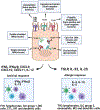The airway epithelium during infancy and childhood: A complex multicellular immune barrier. Basic review for clinicians
- PMID: 34030977
- PMCID: PMC8859843
- DOI: 10.1016/j.prrv.2021.04.002
The airway epithelium during infancy and childhood: A complex multicellular immune barrier. Basic review for clinicians
Abstract
The airway epithelium is a complex multicellular layer that extends from the nasopharynx to the small airways. It functions as an immune respiratory barrier during early life that develops, matures, and regenerates to adapt to the changes in the environment. While airway epithelial abnormalities have been identified in several clinical disorders, there is increasing interest in understanding its basic regulation and structure in humans. Indeed, recent advances in technology (e.g. single-cell analysis and new human airway epithelial cell models) have allowed us to identify additional cellular subtypes and functions that overall have greatly improved our understanding of the airway epithelium during health and disease. In this review we summarize key features of the airway epithelium including: 1) multilayer structure and cell heterogeneity; 2) adaptability to different environmental and developmental stimuli; 3) innate recognition; and 4) orchestration of immune responses. We discuss these features with a translational and clinical prospective focusing on the development of human respiratory immunity, particularly during early life.
Keywords: Airway epithelium; Immune response; Pathogenesis of airway dieseases.
Copyright © 2021 Elsevier Ltd. All rights reserved.
Conflict of interest statement
Declaration of Competing Interest The authors declare that they have no known competing financial interests or personal relationships that could have appeared to influence the work reported in this paper.
Figures


Comment in
-
The guardians of the airway.Paediatr Respir Rev. 2021 Jun;38:1. doi: 10.1016/j.prrv.2021.04.004. Epub 2021 May 4. Paediatr Respir Rev. 2021. PMID: 34020907 No abstract available.
References
-
- Jamieson KC et al. Rhinovirus in the pathogenesis and clinical course of asthma. Chest 2015;148(6):1508–16. - PubMed
Publication types
MeSH terms
Grants and funding
LinkOut - more resources
Full Text Sources
Other Literature Sources
Medical

